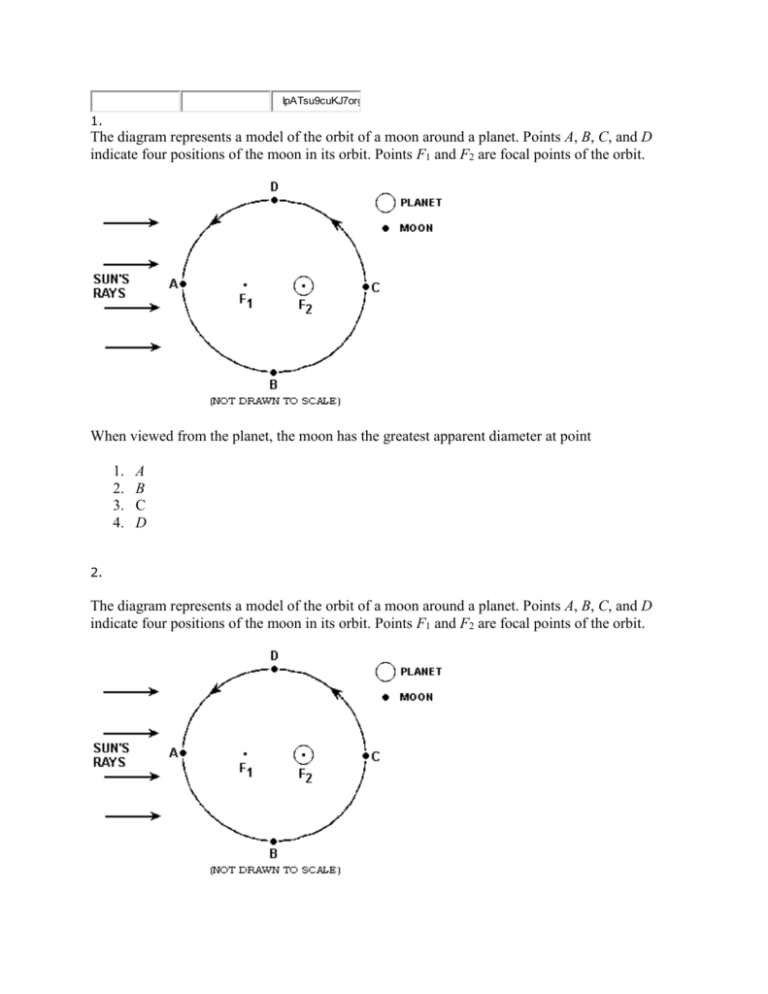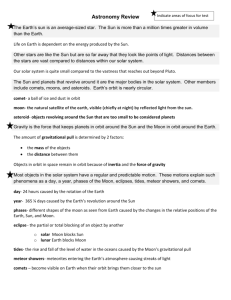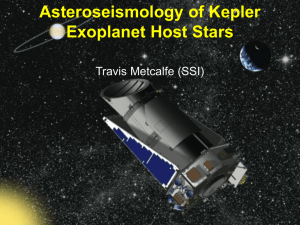File topic iv review quiz
advertisement

IpATsu9cuKJ7org 1. The diagram represents a model of the orbit of a moon around a planet. Points A, B, C, and D indicate four positions of the moon in its orbit. Points F1 and F2 are focal points of the orbit. When viewed from the planet, the moon has the greatest apparent diameter at point 1. 2. 3. 4. A B C D 2. The diagram represents a model of the orbit of a moon around a planet. Points A, B, C, and D indicate four positions of the moon in its orbit. Points F1 and F2 are focal points of the orbit. As the moon moves in its orbit from point D to point B, the force of gravitational attraction between the moon and the planet 1. 2. 3. 4. increases only decreases only increases, then decreases decreases, then increases 3. The diagram represents eight positions of the Moon as it revolves around the Earth. When viewed from the Earth, which phase of the Moon will be seen when the Moon is at point E? 1. 2. 3. 4. first quarter full moon new moon last quarter 4. The diagram shows Earth’s position in its orbit around the Sun at the beginning of each season. Earth’s orbit around the Sun is best described as 1. 2. 3. 4. a perfect circle an oblate spheroid a very eccentric ellipse a slightly eccentric ellipse 5. The diagram shows the relative positions of the Sun, Earth, and Moon in space. Letters A, B, C, and D represent locations on the Earth’s surface. At which location would an observer on the Earth have the best chance of seeing a total solar eclipse? 1. 2. 3. 4. A B C D 6. PlanetA has a greater mean distance from the Sun than planet B. On the basis of this fact, which further comparison can be correctly made between the two planets? 1. 2. 3. 4. Planet A is larger. Planet A’s revolution period is longer. Planet A’s speed of rotation is greater. Planet A’s day is longer. 7. The surface of Venus is much hotter than would be expected, considering its distance from the Sun. Which statement best explains this condition? 1. 2. 3. 4. Venus has many active volcanoes. Venus has a slow rate of rotation. The clouds of Venus are highly reflective. The atmosphere of Venus contains a high percentage of carbon dioxide. 8. The diagram represents part of the night sky, including the constellation Leo. The black circles represent stars. The open circles represent the changing positions of one celestial object over a period of a few weeks. The celestial object most likely represented by the open circles is 1. 2. 3. 4. a galaxy a planet Earth's Moon another star 9. Which planet has vast amounts of liquid water at its surface? 1. 2. 3. 4. Venus Mars Jupiter Earth 10. The diagram represents a standard dark-line spectrum for an element. The spectral lines of this element are observed in light from a distant galaxy. Which diagram represents these spectral lines? 1. 2. 3. 4. 11. Stars spend most of their life as 1. 2. 3. 4. Blue supergiants Main sequence stars White dwarfs Red giants 12. Which two groups of stars can have similar brightness? 1. Blue supergiants and white dwarfs 2. White dwarfs and red giants 3. Red dwarfs and red giants 4. Blue supergiants and supergiants 13. Which of the forces listed below is most responsible for the formation of stars? 1. 2. 3. 4. Gravity Magnetism Electromagnetism Light 14. The Milky Way galaxy is best described as 1. 2. 3. 4. a type of solar system a constellation visible to everyone on Earth a region in space between the orbits of Mars and Jupiter a spiral-shaped formation composed of billions of stars 15. Base your answer to the question on the diagram below, which represents the elliptical orbit of a planet traveling around a star. Points A, B, C, and D are four positions of this planet in its orbit. The calculated eccentricity of this orbit is approximately 1. 2. 3. 4. 0.1 0.2 0.3 0.4 3216240 False 0 0 1









